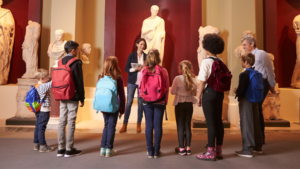
Here’s a simple idea. Every elementary school has crossing guards to ensure that children move safely from home to school, where they will stay safely with one teacher for the remainder of the day. But students switch to having multiple teachers in middle school, and there is no reason by high school that all those teachers need to be in classrooms in school. Safety is still a concern, but crossing guards need to be supplemented with crossing guides: paid, trained staff who see students weekly, if not daily, to establish the expectation that crossings between classes, between grade levels, between peer groups, between identity groups and between the people, places and possibilities found in and outside of the school building is the norm.
These guides can certainly help students find support for things they are struggling with in their academic classes. But their main role is to help students find ways to connect, learn and contribute to things that matter to them inside and outside of school walls and to help them get recognition, if not formal credit, for these crossings.
Learning happens everywhere, all the time, whether or not schools are open. So crossing guides, and probably crossing guards, should be available to be deployed year-round.
The idea that guides are needed to ensure students’ safe, planned daily passages between school and community-based learning environments is compatible with, but different from, the idea of community schools, which brings community partners into the building to expand supports, enrich learning time, and engage parents and family members.
The Learning Policy Institute stated that “Community schools replace the fragmented, bureaucratic, social services gauntlet that families in need must often navigate with a student-focused approach that organizes resources from community partners where they can be most easily accessed: in school. In community schools, students and families are engaged as partners in the educational process and have access to a broad range of well-coordinated supports and services.”
The research is compelling: Students in schools that offer these kinds of supports and services do better in both attendance and achievement. The research is strong enough, in fact, that the Brookings Institution’s Task Force on Next Generation Community Schools called for public investments to transform schools into community schools “centering initial efforts on the 4 percent of school districts that educate approximately 40 percent of the country’s children, include urban and rural communities across the country’s nation, and have the greatest concentration of unmet student needs.”
All schools can, and should, be community schools. But, every school, especially every secondary school, should also see itself as a key actor in vibrant learning communities. It is not enough to bring community programs and resources into the school; guides are also needed to help young people access the opportunities and become active players out into their community.
In March 2022, California significantly enhanced the potential for school and community leaders to act together to support student learning and development through the creation of the California Community Schools Partnership Program. In an Ed Source column, Hayin Kimmer and Marty Blank argue that, if done well, the program “offers schools and districts the opportunity to understand and fill gaps in vital areas identified by students, parents, educators and community partners to weave together existing and new programs into a cohesive and coherent whole.”
The challenge will be getting all stakeholders to see that getting students out into the community is as important as getting services in. Fortunately, Kimmer and Blank’s recommendations of starting points for embarking on the journey for schools to become community schools emphasizes putting staff and structures in place to guide students out into their communities.
Each of the strategies outlined below increases the chances that students will have the guidance and support they need to fully participate in their school and “life” communities. Given the strong association of community schools model with integrated, wraparound services, however, I would charge that we also need to be explicit about what it will take to achieve this stretch goal.
From Strong Community Schools
Toward Integrated School Communities
Establish school site teams of students, parents, educators and community partners to determine how to support students and connect to community resources…
And establish community crossings teams of students, parents, non-classroom staff, and crossing guides to set and manage expectations that every student has regular, during the school day opportunities to advance their interests and skills outside the classroom and the building.
Fill critical gaps by financing programs or deepening strategies that reflect immediate concerns…
And fill opportunity gaps by connecting with and financing existing programs in the community that provide relevant, rigorous, and social capital-building opportunities and experiences.
Hire community school coordinators to serve as site-based “chiefs of staff” to bring strategies and partners together collaboratively…
And hire crossings coordinators to serve as community-based “chief of staff” focused on generating organizational partnerships to support sustainable, scalable pathways for exploration and mastery.
Engage students in community-based learning by facilitating relationships with community groups that have expertise in addressing pressing community issues to create opportunities for meaningful, culture- and place-affirming learning and engagement…
And engage students in competency-based, place-based learning by making explicit links and bridges between academic instruction and pressing issues in ways that motivate students to build foundational knowledge and strengthen fundamental literacies.
To quote a phrase Merita Irby and I coined 30 years ago, “problem-free isn’t fully prepared. And fully prepared isn’t fully engaged.” Providing wraparound supports in a school with weak and inequitable teaching isn’t sufficient. Nor is solely providing student-centered, project-based learning. Adolescents need place-based community embedded learning experiences to build the capacities they need to succeed and to cultivate the motivation to soar.




No comment yet, add your voice below!